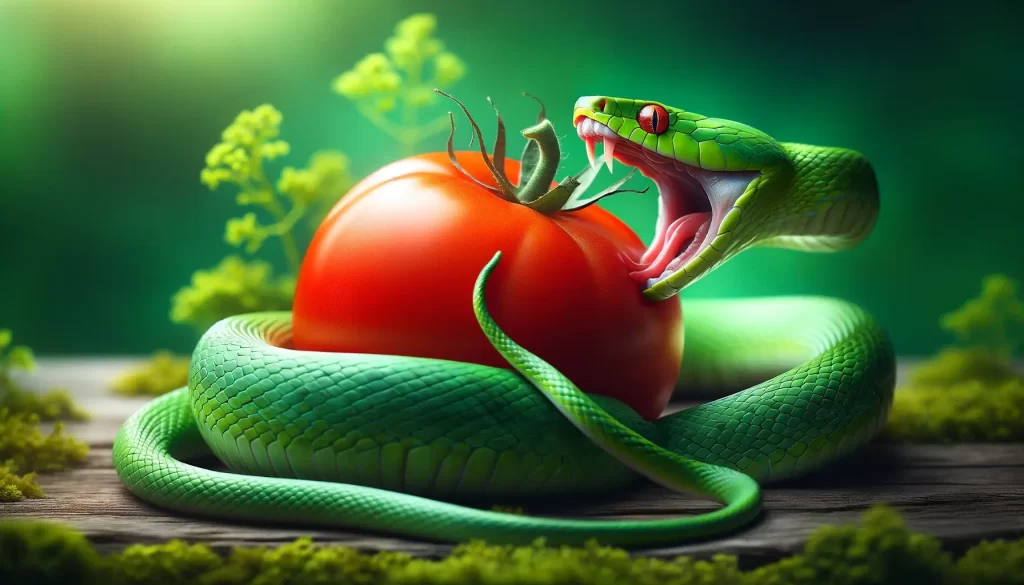Have you ever wondered what snakes eat? The thought of these slithering creatures devouring their prey can both fascinate and intrigue us.
It’s a captivating aspect of their existence, one that showcases the wonders of the natural world we live in.
So, when someone asked me if snakes eat tomatoes, I was just as curious as you might be right now.
Snakes typically do not eat tomatoes or any plant-based foods. They are obligate carnivores, meaning their diet consists exclusively of meat, such as rodents, birds, eggs, and other small animals, depending on the species of snake.
In this article, we will dive deep into the dietary habits of snakes and explore the truth behind the myth surrounding snakes and tomatoes.
Together, we will debunk misconceptions and gain a comprehensive understanding of snake diets and why tomatoes are not part of their typical food choices.
Key Takeaways:
- Snakes have unique dietary needs that primarily consist of other animals
- Their diet may vary among different snake species, influenced by factors like habitat and hunting behavior.
- The myth of snakes eating tomatoes has led to misconceptions about their diets, but we will debunk it with evidence.
- Tomatoes are not suitable for snakes due to their nutritional needs and potential health risks.
- We will share insights into proper feeding practices for pet snakes and tips for ensuring a balanced diet.
Understanding Snake Diets
To understand whether snakes eat tomatoes, it’s important to start by understanding their diets.
Snakes are carnivorous reptiles that primarily consume other animals as their main source of nourishment.
What Do Snakes Typically Eat?
Snakes have a diverse range of food preferences, but their typical diet consists of rodents, birds, eggs, insects, and smaller reptiles.
These prey items provide the necessary nutrients and energy for snakes to thrive.
Variations in Diet Among Different Snake Species
It’s important to note that the specific food preferences can vary among different snake species.
While some snakes are specialists and have a very specific diet, others are generalists and can adapt to a wider range of prey.
This variation in diet is influenced by factors such as habitat, hunting behavior, and physiological needs.
By understanding the typical foods snakes consume and the variations in diet among different snake species, we can better evaluate whether tomatoes would be a suitable addition to their diet.
The Myth About Snakes and Tomatoes
The myth about snakes eating tomatoes has been circulating for some time, leading to misconceptions about whether these reptiles include vegetables in their diets.
It’s important to explore the origins of this myth to understand how it came about and whether there is any truth to it.
By investigating the historical context and popular beliefs surrounding snakes and tomatoes, we can uncover the misconceptions that have contributed to this myth.
Origins of the Myth
The origins of the myth about snakes eating tomatoes are rooted in a combination of misunderstandings and misinterpretations.
Some believe that the myth may have originated from people who witnessed snakes slithering through tomato gardens or coming into contact with discarded tomatoes.
This observation may have led to the misconception that snakes actively seek out and consume tomatoes as part of their diet.

Debunking the Myth
However, it’s important to note that snakes do not typically consume tomatoes as part of their natural diet.
Snakes are carnivorous reptiles with specific dietary needs that are met by consuming other animals.
Their bodies are specifically adapted to digest and extract nutrients from the proteins and fats found in animal prey.
While snakes may occasionally come into contact with tomatoes, they do not actively seek them out or view them as a food source.
Furthermore, the nutritional composition of tomatoes does not align with the dietary requirements of snakes.
Tomatoes are primarily composed of water and carbohydrates, with minimal protein content.
Snakes require a diet rich in protein to support their growth, development, and overall health.
Feeding snakes tomatoes can result in nutritional deficiencies and digestive issues, potentially leading to detrimental health consequences.
In conclusion, the myth that snakes eat tomatoes is a misconception that should be debunked.
Snakes are carnivorous reptiles with specific dietary needs that are met by consuming other animals.
Tomatoes are not a suitable part of their diet and can have adverse effects on their health.
It’s important for snake owners and enthusiasts to have accurate knowledge about the dietary needs of these reptiles to ensure their well-being.
Why Tomatoes Are Not a Suitable Food for Snakes
While it’s clear that snakes do not typically eat tomatoes, it’s important to understand why tomatoes are not a suitable food choice for these reptiles.
Snakes have specific nutritional needs that must be met to maintain their health and vitality.
Tomatoes do not provide the essential nutrients and dietary requirements that snakes require for optimal well-being.
Nutritional Needs of Snakes
Snakes require a balanced and appropriate diet to thrive. Their nutrition needs are primarily focused on acquiring adequate protein, vitamins, and minerals.
Protein is essential for growth, development, and tissue repair in snakes. It helps maintain muscle strength and overall health.
Snakes also need vitamins, such as vitamin D, for proper calcium absorption and bone health.
Minerals like calcium and phosphorus are crucial for bone structure, nerve function, and metabolic processes in snakes.
Potential Health Risks
Feeding tomatoes to snakes can pose potential health risks due to their unsuitability as snake food.
Tomatoes have a high water content and are low in essential nutrients required by snakes.
Eating tomatoes can cause digestive issues in snakes and may result in nutrient deficiencies over time.
Snakes have specific dietary requirements, and feeding them unsuitable food like tomatoes can lead to malnutrition, weakened immune systems, and other health complications.
Proper Feeding Practices for Pet Snakes
Feeding pet snakes appropriately is crucial for their health and happiness. As responsible pet owners, it’s important to follow proper feeding practices to ensure the well-being of our beloved reptilian friends.
By providing a suitable diet that closely resembles what snakes would eat in the wild, we can meet their specific nutritional needs and promote a balanced diet.
Recommended Foods for Snakes
When it comes to feeding pet snakes, it’s important to consider their species, size, and dietary preferences.
Snakes are carnivorous reptiles, so their diet primarily consists of other animals. Common food choices for snakes include rodents, such as mice and rats, birds, and smaller reptiles.
It is essential to offer appropriately sized prey that is suitable for your snake’s size and age. Frozen-thawed prey is generally recommended as it reduces the risk of parasites and injuries.
Foods to Avoid
While providing the right foods is important, it’s equally essential to be aware of the foods that should be avoided when feeding pet snakes.
Some items can be harmful or toxic to snakes and can pose serious health risks.
Avoid feeding your pet snake:
- ❌ Live prey that can cause injuries to the snake.
- ❌ Poisonous animals.
- ❌ Insects that have been exposed to pesticides.
- ❌ Foods with sharp bones or hard shells.
By avoiding these foods, we can prevent potential harm to our pet snakes and ensure their well-being.
How to Ensure a Balanced Diet for Your Pet Snake
Ensuring a balanced diet for your pet snake is crucial for their overall health and well-being.
While providing the right food choices is important, there are other factors to consider to promote a healthy diet. Here are some valuable tips for feeding pet snakes:
Tips for Feeding Pet Snakes
- Feeding Frequency: Snakes have different feeding frequencies based on their age and species. It’s important to research and understand the specific feeding requirements of your pet snake. Generally, younger snakes require more frequent feedings compared to adult snakes.
. - Portion Sizes: The size of the prey should be appropriate for the size and age of your snake. It’s important to avoid offering prey that is too large or too small. A general rule is to provide prey that is approximately the same width as the widest part of your snake’s body.
. - Monitoring Eating Habits: Pay attention to your snake’s eating habits. It is normal for snakes to have periods of reduced or no appetite, especially during shedding or inactivity. However, a significant decrease in appetite or refusal to eat for an extended period may indicate an underlying health issue. Consult with a reptile veterinarian if you have concerns about your snake’s eating habits.
By following these tips, you can create a feeding routine that suits your pet snake’s needs and promotes a healthy diet.
Consulting With a Reptile Veterinarian
Consulting with a reptile veterinarian is essential for maintaining your pet snake’s overall health.
Reptile veterinarians specialize in exotic animal care and can provide expert advice on snake nutrition, dietary supplements, and any specific dietary concerns based on your pet’s species and individual requirements.
They can also help you identify any potential health issues and provide appropriate treatment or preventive care.
Regular check-ups and consultations with a reptile veterinarian will ensure that your snake receives the best care possible.
Conclusion
In conclusion, it is evident that snakes do not typically include tomatoes in their natural diet.
The myth surrounding snakes and tomatoes has resulted in misinformation and confusion about the dietary requirements of these reptiles.
By gaining knowledge about the usual foods consumed by snakes and the variations in their diet among different species, we can confidently debunk this myth and provide accurate information.
It is crucial to acknowledge that tomatoes are not suitable as a food source for snakes due to their specific nutritional needs and potential health risks.
Snakes require a well-balanced diet that closely resembles their natural dietary preferences.
It is important for snake owners to follow proper feeding practices and offer appropriate foods to ensure the well-being of their pets.
Responsible pet ownership involves understanding and meeting the nutritional requirements of snakes.
By implementing feeding tips and consulting with a reptile veterinarian, snake owners can ensure optimal nutrition for their pet snakes.
Reptile veterinarians specialize in exotic animal care and can provide expert advice on snake nutrition, dietary supplements, and any individual diet concerns based on the species.
Taking these measures contributes to the overall health and happiness of pet snakes and promotes responsible ownership.
Frequently Asked Questions
Q: Can snakes eat tomatoes in the garden?
A: Snakes do not eat tomatoes or any plant matter as they are obligate carnivores, meaning their diet consists entirely of meat.
Q: Can snakes eat tomato seeds?
A: No, snakes do not eat tomato seeds or any part of a tomato plant. Their digestive systems are not designed to process plant material.
Q: Do snakes eat fruit and vegetables?
A: No, snakes do not eat fruits or vegetables. Their diet is purely carnivorous, feeding on prey such as rodents, birds, eggs, and insects, depending on the species.
Q: What should you not feed a snake?
A: You should not feed snakes plant-based foods, dairy products, or processed human foods. Their diet should consist of appropriate-sized prey items suitable for their specific species and size.
Q: What household foods can snakes eat?
A: Snakes should not be fed household foods. They require a diet of live or frozen-thawed prey, such as mice, rats, or other animals, depending on the snake’s size and species.
Q: What can I feed my snake instead of mice?
A: If not feeding mice, you can offer rats, chicks, or rabbits, depending on the snake’s size. Some species may also eat fish or insects. It’s essential to provide prey suitable for the snake’s dietary needs and size.
Q: What do snakes like to eat the most?
A: Snakes prefer eating live or appropriately sized prey that they can swallow whole. This includes mice, rats, birds, and other small animals. The preferred food varies by species and what they would naturally hunt in the wild.




